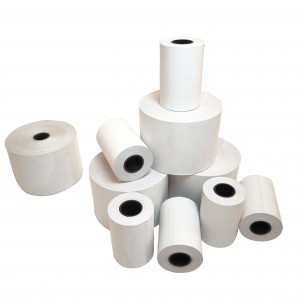At the critical moment of commercial transactions, cash register paper carries the voucher function of consumer contracts. This inconspicuous choice of consumables actually implies shrewd business wisdom. Size, as the basic parameter of cash register paper, directly affects transaction efficiency, operating costs and customer experience, reflecting the depth of the operator’s understanding of the essence of business.
1. The underlying logic of equipment adaptation
The primary principle of cash register paper size selection is equipment matching. The mainstream cash registers on the market are compatible with two specifications of 57mm and 80mm. The former is more common in convenience store barcode scanners, and the latter is common in supermarket cash register systems. Some catering companies use 110mm wide paper to print receipts with menu details. The parameter “paper roll outer diameter ≤50mm” marked in the equipment manual is often overlooked but crucial. Oversized paper rolls will cause paper jams. A chain of milk tea shops once caused a 30% equipment repair rate due to the purchase of 75mm outer diameter paper rolls. This lesson confirms the value of precise adaptation.
2. Efficiency rules for content presentation
57mm narrow paper can print 18-22 characters in a single line, which is suitable for printing basic transaction information; 80mm paper can accommodate 40 characters, which can meet the display of value-added content such as promotional information and member QR codes. Fast food giant McDonald’s uses 80mm receipts to print meal codes and promotional coupons, increasing the average customer spending by 12%. The medical industry uses special 110mm paper to print prescription details, which not only meets regulatory requirements but also enhances the professional image. Content planning should form a dynamic balance with paper width to avoid visual confusion caused by information overload.
3. Hidden battlefield of cost control
The hidden costs of paper rolls of different sizes vary significantly. The length of a single roll of 80mm paper is usually 50 meters, which reduces the effective usage by 30% compared with 57mm paper of the same outer diameter. The average daily consumption of 80mm paper used by catering companies is 2.5 times higher than that of 57mm paper used by convenience stores. A medium-sized supermarket reduced its annual consumables cost by 80,000 yuan by switching to 57mm paper and optimizing printing. However, blindly pursuing small size may lead to customer complaints caused by missing important information, and cost control needs to take into account business integrity.
The choice of cash register paper size is essentially a concrete expression of business rationality. In the triangle relationship of equipment compatibility, information carrying capacity, and cost-effectiveness, each choice should point to the core goal of improving transaction efficiency and optimizing consumer experience. When operators begin to consider daily operations with millimeter-level precision, it is a sign that their business thinking is maturing. This control over details will eventually be transformed into a differentiated competitive advantage in the fierce market competition.
Post time: Feb-14-2025


